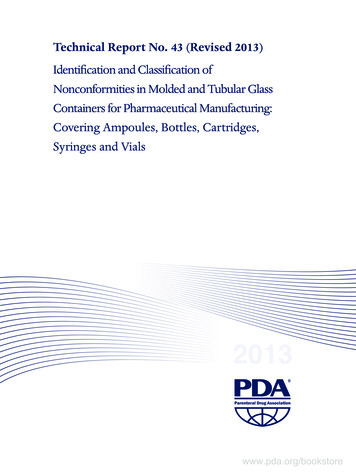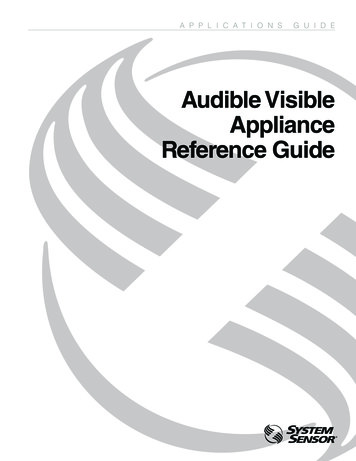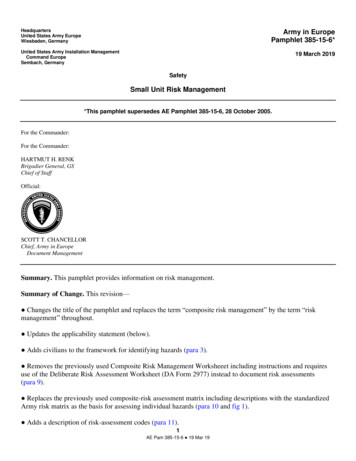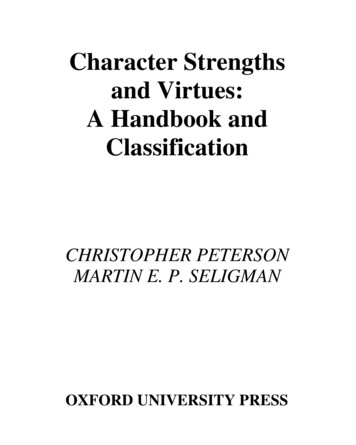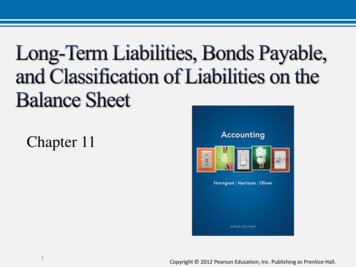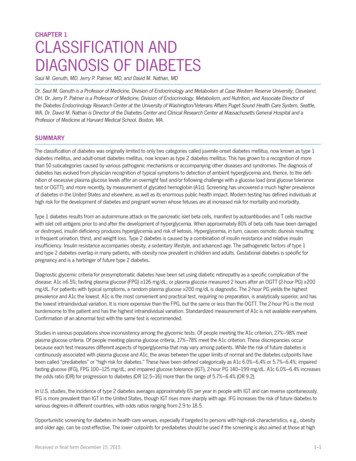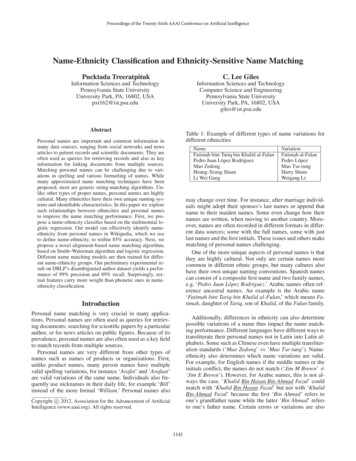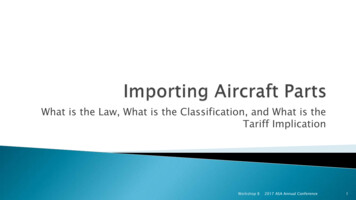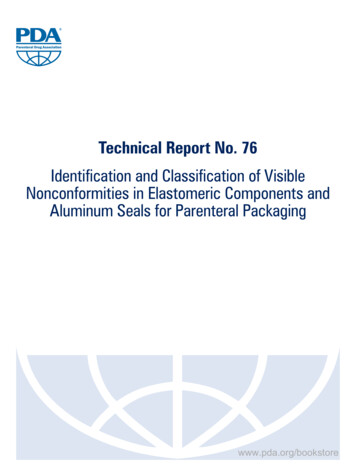
Transcription
Technical Report No. 76Identification and Classification of VisibleNonconformities in Elastomeric Components andAluminum Seals for Parenteral Packagingwww.pda.org/bookstore
PDA Identification and Classification of Visible Nonconformities in Elastomeric Components andAluminum Seals for Parenteral Packaging Technical Report TeamAuthorsSuzanne Seeley, Merck & Company, Inc., Co-ChairPatty H. Kiang, Ph.D., Kiang Consultant ServicesAndrea Straka, West Pharmaceutical Services, Inc.,Co-ChairEric Lebossé de Lannoy, EMA PharmaceuticalsRoger Asselta, Genesis Packaging TechnologiesJames McFarland, Gerresheimer Glass Inc.Kristin Bartholomay, Baxalta US IncDouglas Cusato, BD Medical - Pharm SystemsMichael N. Eakins, Ph.D., Eakins & AssociatesBrian Gallagher, Aptar StelmiChristopher Lau, Baxalta US IncSarvang Mishra, SanofiMunyee Pang, Merck & Company, Inc.Kishan Rijal, Ph.D, GlaxoSmithKlineDana Morton Guazzo, Ph.D., RxPax LLCWayland Rushing, Ph.D., Analytical Bio-ChemistryLaboratories, Inc.Friedrich Haefele, Boehringer Ingelheim PharmaGmbH & Co. KGEdward J. Smith, Ph.D., Packaging Science Resources,LLCLiz Herring, DatwylerDawn Watson, Merck & Company, Inc.Lucia Ino, West Pharmaceutical Services, Inc.Kim White, BD Medical - Pharm SystemsJennifer Johns, Pfizer Inc.Lisa Yoest, GlaxoSmithKlineAcknowledgementsThe photographs and drawings for the components in this Technical Report and in the accompanying lexicons werecollected by a subgroup of the Elastomeric Component and Aluminum Seal Technical Report Team called the Elastomer TRT Working Group. PDA would like to acknowledge the contributions of the Elastomer TRT Working Groupand Lawrence Pepper III of Genesis Packaging Technology for providing high quality images which were used in thedevelopment of the lexicons. John G. Shabushnig of Insight Pharma Consulting, LLC and Rick Watson of Merck alsoprovided expert insight and review during the global peer review.Disclaimer: The content and views expressed in this Technical Report are the result of a consensus achieved by theauthorizing Technical Report Team and are not necessarily the views of the organizations they represent.www.pda.org/bookstore
Identification andClassification of VisibleNonconformities inElastomeric Componentsand Aluminum Seals forParenteral PackagingTechnical Report No. 76ISBN: 978-0-939459-92-6 2016 Parenteral Drug Association, Inc.All rights reserved.Bethesda Towers4350 East West HighwaySuite 200Bethesda, MD 20814 USATel: 1 (301) 656-5900Fax: 1 (301) 986-0296E-mail: info@pda.orgWeb site: www.pda.orgwww.pda.org/bookstore
Table of Contents1.0 INTRODUCTION 11.1 Purpose and Scope 12.0 GLOSSARY OF TERMS 23.0 ELASTOMERIC COMPONENTS AND ALUMINUMSEALS CONFORMANCE SPECIFICATIONDEVELOPMENT PROCESS 43.1 Dimensional Development 43.2 Elastomeric Components and AluminumSeals Sampling 43.2.1 Definition of Lots 53.2.2 Sampling Plans 53.2.2.1 Defective Parts Per Million 53.2.3 Acceptance Quality Limits 63.3 Elastomeric Component and Aluminum SealNonconformity Lexicon 73.3.1 Considerations for EstablishingNonconformity Classifications 73.3.1.1 Component Preparation 73.3.1.2 Risk Assessment 83.3.1.3 Inspection Plan 83.3.1.4 Container Closure Integrity (CCI) 83.3.1.5 Particulate Contamination 93.4 Documentation and Training 94.0 IDENTIFICATION AND CLASSIFICATION OFVISIBLE NONCONFORMITIES 104.1 Elastomeric Vial Stoppers 104.1.1 Elastomer Packaging Components 104.1.2 Vial Container Closure Integrity (CCI)Considerations 124.1.3 Elastomeric Vial Stopper Noncomformities 134.2 Aluminum Seals 164.2.1 Aluminum Seal Components 164.2.2 Aluminum Seal Nonconformities 215.0 CONCLUSION 246.0 REFERENCES 257.0 ADDITIONAL READING 268.0 APPENDIX A: ELASTOMERIC VIAL STOPPERNONCONFORMITY LEXICON 289.0 APPENDIX B: ALUMINUM SEALNONCONFORMITY LEXICON 41FIGURES AND TABLES INDEXFigure 4.1.1-1Figure 4.1.1-2Figure 4.1.1-3Figure 4.1.1-4Figure 4.1.2-1Table 4.1.2-1Table 4.1.3-1Figure 4.2.1-1Figure 4.2.1-2Figure 4.2.1-3Stopper Nomenclature — StandardTerms (Serum & Lyo) 11Stopper Nomenclature — AdditionalCommon Features (Serum & Lyo) 11Stopper Nomenclature — AdditionalCommon Features 11Stopper Nomenclature — Coatingsand Laminates (Serum & Lyo) 12Vial Container Closure Integrity(CCI) Considerations 12Vial Container Closure Integrity(CCI) Considerations 13Elastomeric Vial StopperNonconformity List 14Composition of a Vial Seal 16Composition of a Lined Seal 16Bridge 16Figure 4.2.1-4Figure 4.2.1-5Figure 4.2.1-6Figure 4.2.1-7Figure 4.2.1-8Figure 4.2.1-9Figure 4.2.1-10Figure 4.2.1-11Figure 4.2.1-12Figure 4.2.1-13Figure 4.2.1-14Figure 4.2.1-15Figure 4.2.1-16Table 4.2.2-1Score 17Lacquer 17Rolled Groove 17Melt 18Fingers 18Aluminum Ferrule 18Elastomer Lined Aluminium Ferrule 19Center Tear Out 19Tear Off 19Pull Off Ring 20ALU/Plastic Flip Cap 20Flip and Tear Off 21Flip Off then Tear Off 21Aluminum Seal Nonconformity List 22www.pda.org/bookstore
1.0 IntroductionPharmaceutical companies and suppliers of elastomeric components and aluminum seals often makequality decisions based on visual inspections of these packaging components without the aid of universal guidelines or standards. Inconsistency in defining elastomeric component and aluminum sealnonconformities has resulted in a non-uniform approach in meeting regulatory expectations to deliverhigh-quality pharmaceutical products.PDA members recognized the need to provide consensus-based best practices for the identificationand classification of elastomeric component and aluminum seal nonconformities in the form of aconsensus-based Technical Report. A task force, representing a broad cross-section of both suppliersand pharmaceutical manufacturing professionals, was formed to create a consensus document.Technical Report No. 76 provides an approach to a quality decision-making process; implementationof that approach, however, is the responsibility of each organization. The following represents what theauthors believe are best practices for identifying and classifying visual nonconformities for elastomericcomponents and aluminum seals.1.1Purpose and ScopeThe purpose of this technical report is to provide consistent and standardized quality criteria that canbe used by pharmaceutical and medical device manufacturers for the visual inspection of incomingelastomeric components and aluminum seals, and by suppliers for outgoing inspection. Post-fillinginspection for these nonconformity types in filled containers are out of scope and should be establishedon similar patient risk assessment principles.Note: In this report, the term “pharmaceutical” is used to designate both pharmaceuticals and medicaldevices.Included in scope are elastomeric and aluminum components used for parenteral packaging and delivery, including but not limited to elastomeric vial stoppers, seal liners, and aluminum and aluminum/plastic seals. Out of scope are diagnostics and components, such as blood collection stoppers, andmedical device components such as gaskets, diaphragms, and O-rings. Detailed lexicons that visuallyillustrate commonly observed nonconformities in elastomeric components and aluminum seals areincluded.The identification and classification of elastomeric component and aluminum seal visual nonconformities represent only one part of the overall quality requirements. Examples of additional qualityrequirements may include adherence to dimensional standards, functional requirements, compendialrequirements, incoming lot sampling program, and acceptance quality limits. This report provides abuilding block for developing a comprehensive specification for elastomeric components and aluminum seals.This report is not intended to establish mandatory standards for the classification and identificationof elastomeric component and aluminum seal nonconformities; it is intended to be a single-sourceoverview that complements existing guidelines and standards or documents listed in the referencesection of this technical report. For greater detail on various topics throughout this report, suggestions for additional reading have been provided. It is always advisable to consult with the appropriateregulatory authority for agreement on the strategies employed for the identification and classificationof visual nonconformities in elastomeric components and aluminum seals, and other similar packaging components.www.pda.org/bookstoreTechnical Report No. 76 2016 Parenteral Drug Association, Inc.1
and Lawrence Pepper III of Genesis Packaging Technology for providing high quality images which were used in the development of the lexicons. John G. Shabushnig of Insight Pharma Consulting, LLC and Rick Watson of Merck also provided expert insi
